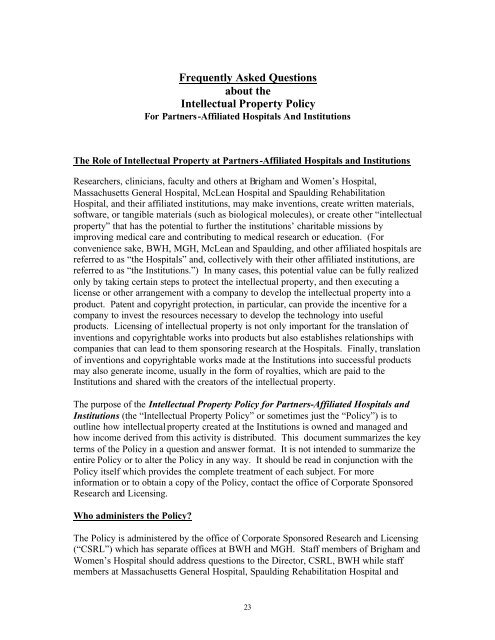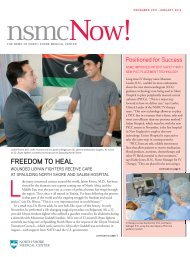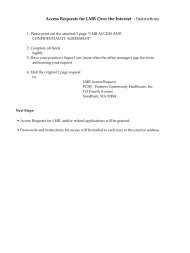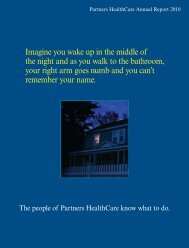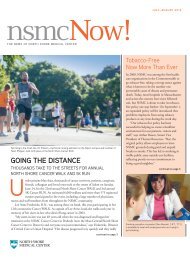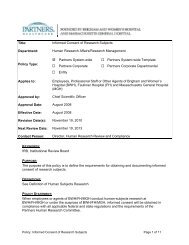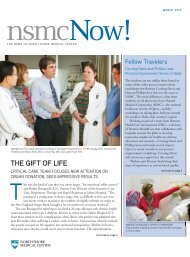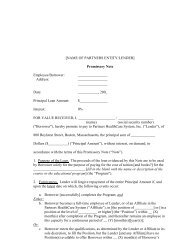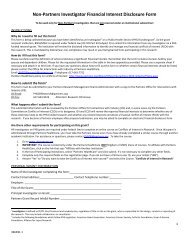Frequently Asked Questions about the Intellectual Property Policy
Frequently Asked Questions about the Intellectual Property Policy
Frequently Asked Questions about the Intellectual Property Policy
You also want an ePaper? Increase the reach of your titles
YUMPU automatically turns print PDFs into web optimized ePapers that Google loves.
McLean Hospital should address questions to <strong>the</strong> Director, CSRL, MGH. Faculty at <strong>the</strong>MGH Institute of Health Professions should first direct <strong>the</strong>ir questions to <strong>the</strong> AcademicDean.Who is covered by <strong>the</strong> <strong>Policy</strong>?The <strong>Policy</strong> applies to all Medical or Professional Staff (including individuals holdingappointments as Visiting Staff) of MGH, BWH, McLean and Spaulding or a hospitalaffiliated with any of <strong>the</strong>m; and to each faculty member, student, and employee of <strong>the</strong>Hospitals or ano<strong>the</strong>r Institution (whe<strong>the</strong>r <strong>the</strong>ir activities at <strong>the</strong> Institution are full- or parttime),including employees of <strong>the</strong> Hospital-affiliated physicians’ organizations andfoundations. The <strong>Policy</strong> also applies to each visitor from, student or researcher of, oro<strong>the</strong>r person primarily affiliated with any o<strong>the</strong>r institution, and each person holding afellowship, who performs educational, research, clinical or o<strong>the</strong>r activities at anInstitution. People covered by <strong>the</strong> <strong>Policy</strong> are referred to as “Members.”What is <strong>the</strong> “<strong>Intellectual</strong> <strong>Property</strong> Acknowledgement?”The Institutions have long required that Members sign a document that acknowledges<strong>the</strong>ir obligations under <strong>the</strong> <strong>Intellectual</strong> <strong>Property</strong> <strong>Policy</strong>. For many years this documenthas been called “<strong>the</strong> Participation Agreement;” it has recently been changed and is nowcalled “<strong>the</strong> <strong>Intellectual</strong> <strong>Property</strong> Acknowledgement.” It is important to note that aMember is subject to <strong>the</strong> <strong>Intellectual</strong> <strong>Property</strong> <strong>Policy</strong> regardless of whe<strong>the</strong>r s/he signs <strong>the</strong><strong>Intellectual</strong> <strong>Property</strong> Acknowledgement.What types of “<strong>Intellectual</strong> <strong>Property</strong>” are covered by <strong>the</strong> <strong>Policy</strong>?The bulk of this <strong>Policy</strong> is devoted to <strong>the</strong> two types of intangible, or “intellectual,”property most common in an academic institution. The first type is inventions. These arefrequently protectable by obtaining a patent; however <strong>the</strong> <strong>Policy</strong> covers many inventionsand discoveries even if <strong>the</strong>y are not patentable. The second common type of <strong>Intellectual</strong><strong>Property</strong> consists of written works and o<strong>the</strong>r materials that are protectable as copyrightedworks. (Software is always copyrightable and in many instances may also be patentable;<strong>the</strong> <strong>Policy</strong> treats any software that is patentable as an invention.) Although lesssignificant at <strong>the</strong> Institutions, <strong>the</strong> <strong>Policy</strong> also addresses two o<strong>the</strong>r common types ofintellectual property: trademarks and trade secrets. Finally, <strong>the</strong> <strong>Policy</strong> also addressestangible research property, which are research results in a tangible form such asbiological molecules.What is an invention? What inventions are patentable?For <strong>the</strong> purposes of <strong>the</strong> <strong>Policy</strong>, an “Invention” is defined as any patentable invention (asdefined by patent law), or any o<strong>the</strong>r idea or its embodiment that is potentially patentableor, even if not patentable, may have charitable or commercial value. GenerallyInventions consist of potentially new and useful processes, methods, machines,compositions of matter or articles of manufacture or any improvement of any of <strong>the</strong>se,whe<strong>the</strong>r patentable or not.24
Who owns Inventions and Copyrightable Works?During <strong>the</strong> period of time that you are a Member, <strong>the</strong> Institution owns all Inventions andCopyrightable Works (o<strong>the</strong>r than Academic Works—see Section 8.1.4 of <strong>the</strong> <strong>Policy</strong>)which you conceive or reduce to practice, author or create:• in performing activities that received direct or indirect financial support from <strong>the</strong>Institutions;• in performing activities that made substantial use of any space, facilities materialsor o<strong>the</strong>r resources of <strong>the</strong> Institution;• in performing activities that were o<strong>the</strong>rwise subject to a grant, contract or o<strong>the</strong>rarrangement between an Institution and a third party; or• (in <strong>the</strong> case of Inventions and Software only) that arise out of or relate to yourclinical, research, educational or o<strong>the</strong>r activities at <strong>the</strong> Institution.The Institution also owns all Copyrightable Works created by you at <strong>the</strong> request of <strong>the</strong>Institution, or as part of an Institutional undertaking and, if you are not a Professional orMedical Staff or faculty member, any o<strong>the</strong>r Copyrightable Work created in <strong>the</strong> scope ofyour employment or affiliation with <strong>the</strong> Institution.Note that if an Invention or Copyrightable Work meets none of <strong>the</strong> criteria above, it isowned by <strong>the</strong> Member. A concept for a new business opportunity, for example, is notowned by <strong>the</strong> Institution if <strong>the</strong> concept is unrelated to any activities of <strong>the</strong> Member at <strong>the</strong>Institution, a situation most likely to occur with Professional or Medical Staff Memberswho do not have any administrative responsibilities at <strong>the</strong> Institution. For additionaldetails regarding ownership of intellectual property, please refer to Sections 5.0 and 8.0of <strong>the</strong> <strong>Policy</strong>.What <strong>about</strong> journal articles and o<strong>the</strong>r academic publications?Academic publications of Medical or Professional Staff and students fall under <strong>the</strong>definition of Academic Works (Section 8.1.4 of <strong>the</strong> <strong>Policy</strong>) and generally belong to <strong>the</strong>irauthors, in full accord with academic tradition.Should I publish or let <strong>the</strong> Hospital file for patent protection?Both. It is not a matter of having to chose between patents and publications; both arecompatible. You should keep in mind that one of <strong>the</strong> criteria for patentability is novelty –that <strong>the</strong> idea not be known publicly – and this criteria is lost once <strong>the</strong>re is a publication.Therefore, if you are planning an imminent publication or presentation, contact CSRL todisclose your Invention as soon as possible. CSRL will work with you to protect yourInvention as broadly as possible with no or minimal impact on yourpublication/presentation plans. Once a patent is filed, you are <strong>the</strong>n able to publish oro<strong>the</strong>rwise publicly disclose your Invention without jeopardizing your patent rights.26
Are <strong>the</strong>re any o<strong>the</strong>r constraints on when I may publish?If an Invention arose under a sponsored research agreement, some additional delay inpublication may be required to comply with contractual obligations.What happens to Inventions owned by <strong>the</strong> Institutions?Once an Invention is fully disclosed, <strong>the</strong> Director of CSRL will assign a case manager toverify that <strong>the</strong> Institution owns <strong>the</strong> Invention. CSRL will determine whe<strong>the</strong>r to file apatent application, taking into account <strong>the</strong> Invention’s commercial potential,requirements of any agreement, o<strong>the</strong>r pertinent facts. If a decision is made to file anapplication, <strong>the</strong> case manager will work with you and outside patent counsel to prepareand file <strong>the</strong> application, at <strong>the</strong> Institution’s expense. The case manager will explore <strong>the</strong>commercial prospects, and (for Inventions which are not already subject to licensingobligations) consider potential licensee companies and, when appropriate, negotiate anddraft a license agreement to transfer certain commercial rights to <strong>the</strong> company. If <strong>the</strong>Inventions is licensed, <strong>the</strong> case manager will continue to monitor <strong>the</strong> relationship with <strong>the</strong>licensee company to ensure diligent development of <strong>the</strong> licensed Invention. See also<strong>Policy</strong> Sections 6.4 and 11.4.Are <strong>the</strong>re o<strong>the</strong>r things I should keep in mind regarding copyright?While “Academic Works” are owned by Members, o<strong>the</strong>r written materials, along withsoftware and video products that are increasingly being developed with Institutionalinvolvement, are often owned by <strong>the</strong> Institutions under <strong>the</strong> <strong>Policy</strong>. It is best that anyonewho develops software, videos, patient handbooks, educational materials, or o<strong>the</strong>rcopyrightable works in connection with Institutional activities be aware of copyrightconcerns before a project begins, to be sure that <strong>the</strong> work can be used as intended when itis finished. This is particularly important if consultants or o<strong>the</strong>rs outside <strong>the</strong> Institutionare involved, if <strong>the</strong> work is based on pre-existing material, or if you plan to distribute itoutside <strong>the</strong> Institution. See <strong>Policy</strong> Sections 8.3, 9.0 and 10.0.What are my obligations with respect to Tangible Research <strong>Property</strong>?Tangible Research <strong>Property</strong> (or TRP) that is patentable is treated as an Invention whileany TRP that is copyrightable is treated as a Copyrightable Work. TRP that is nei<strong>the</strong>rpatentable nor copyrightable should be disclosed if <strong>the</strong> originator intends to distribute <strong>the</strong>TRP outside <strong>the</strong> Institutions. The Institutions recognize that making TRP available too<strong>the</strong>rs, particularly academic colleagues, is an important part of <strong>the</strong>ir research mission.However, because of safety issues, patient consent issues, contractual obligations, aswell as policies, laws and regulations relating to distribution of certain categories of TRP,distribution of TRP to industrial entities, distribution of TRP comprising patient tissues,and distribution of certain categories of TRP to any outside entity must first be approvedby CSRL. See <strong>Policy</strong> Section 16.27
May I sign “material transfer agreements,” confidentiality agreements, or o<strong>the</strong>ragreements that address intellectual property without institutional review?No. While you are a Member, all such agreements must be reviewed and approved by <strong>the</strong>Institution and, in most cases, <strong>the</strong> appropriate office to review <strong>the</strong> agreement will beCSRL. See <strong>Policy</strong> Section 4.If I consult for a company, can <strong>the</strong> company own my Inventions?Companies usually expect to own inventions made in <strong>the</strong> scope of a consultancy, eventhough such inventions would, in many cases, be considered “related Inventions” (seeSection 5.2.2 of <strong>the</strong> <strong>Policy</strong>) which are normally owned by <strong>the</strong> Institution. If you wish toconsult, <strong>the</strong> <strong>Policy</strong> provides a way to obtain an exception from Institutional ownership –in advance – for Inventions that relate to your work at <strong>the</strong> Institution but which arecreated off-site and at <strong>the</strong> expense of <strong>the</strong> company. In order to obtain that exception, youmust submit your consulting agreement to CSRL for review (Section 5.2.2.1) whichreview is in any case required under <strong>the</strong> Institution’s Consulting <strong>Policy</strong>(http://healthcare.partners.org/OGCpolicies/Consulting.pdf ).How are royalties distributed?All royalties are collected by CSRL and are distributed at regular intervals throughout <strong>the</strong>fiscal year. In general, royalties on Inventions, Copyrightable Works, and TangibleResearch <strong>Property</strong>, net of certain expenses attributable to protecting and licensing <strong>the</strong>property, are distributed as follows: 25% to <strong>the</strong> Creators, 25% to <strong>the</strong> Creators’Laboratory or Unit, 25% to <strong>the</strong> Creators’ Department or Service and 25% to <strong>the</strong>Creators’ Institution. (“Creators” means ei<strong>the</strong>r <strong>the</strong> inventors of an Invention, or <strong>the</strong>individuals who contributed to a copyrighted work and who are entitled to a share ofroyalty income under Section 17.3 of <strong>the</strong> <strong>Policy</strong>. If <strong>the</strong>re is no clear Lab or Unit, thatshare will be paid to institutional accounts in <strong>the</strong> name of senior Creators, <strong>the</strong> funds to beused to support <strong>the</strong>ir research or o<strong>the</strong>r charitable activities while <strong>the</strong>y remain at <strong>the</strong>Institution.) However, income from Copyrightable Works that are “made for hire” suchas computer programs written by employees hired to be programmers is generallyretained by <strong>the</strong> Institution. Laboratories may adopt <strong>the</strong>ir own policies for reallocating <strong>the</strong>Creator’s share of income from Copyrightable Works – for example, devoting it to labpurposes or sharing it with all lab members, if <strong>the</strong> work to be created is a team effort.(Section 17 and Table I provide full details on income distribution.)What happens to my share of royalties if I leave <strong>the</strong> Institution?If you leave <strong>the</strong> Institution, your portion of <strong>the</strong> Creators’ share will continue to be paid toyou. The rest of <strong>the</strong> proceeds will remain at <strong>the</strong> Institution.What happens if I don’t agree with a decision made by CSRL?28
The Professional and Institutional Conduct Committee of Partners HealthCare, whichincludes representative members of <strong>the</strong> Hospital communities, provides general oversightof <strong>the</strong> administration of <strong>the</strong> <strong>Policy</strong>. Disputes shall be resolved under <strong>the</strong> oversight of thisCommittee. (See <strong>Policy</strong> Section F.)Are <strong>the</strong>re o<strong>the</strong>r policies that I should know <strong>about</strong>?You should be aware that you may be subject to a number of o<strong>the</strong>r policies. In particular,two important policies address conflicts of interest: <strong>the</strong> “Partners HealthCare SystemCode of Conduct”( http://healthcare.partners.org/OGCpolicies/Code/index.html ), and <strong>the</strong>“Harvard Medical School <strong>Policy</strong> on Conflicts of Interest and Commitment”(http://www.hms.harvard.edu/integrity/conf.html ).In addition to <strong>the</strong> Consulting <strong>Policy</strong> mentioned above(http://healthcare.partners.org/OGCpolicies/Consulting.pdf), o<strong>the</strong>r relevant policies andguidelines include “Guidelines Regarding Gifts from Industry to Support EducationalPrograms” (http://intranet.partners.org/OGC/policies/EducationalGift<strong>Policy</strong>.pdf);“Guidelines for Attribution of Credit and Disposition of Research Products”(http://www.hms.harvard.edu/fa/attribution.html); and <strong>the</strong> HMS “Faculty <strong>Policy</strong> onIntegrity in Science” (http://www.hms.harvard.edu/integrity), which includes <strong>the</strong> abovereferencedconflicts of interest policy.Additional policies and guidelines are distributed from time to time by Harvard MedicalSchool and Partners HealthCare System and <strong>the</strong> individual hospitals, some of which areposted on http://www.hms.harvard.edu/fa/ andhttp://intranet.partners.org/ogc/OGCpolicies.asp.72751v929


